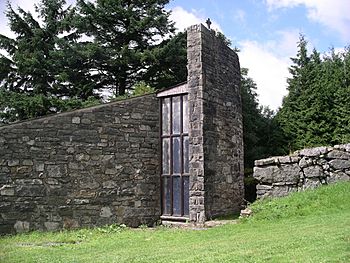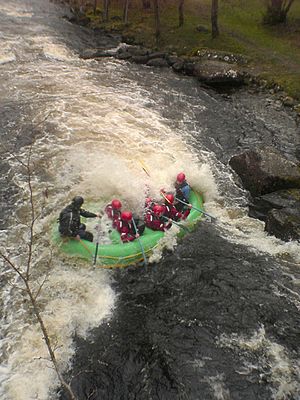Afon Tryweryn facts for kids
Quick facts for kids Afon Tryweryn |
|
|---|---|

Memorial chapel to the flooded village of Capel Celyn
|
|
| Lua error in Module:Location_map at line 420: attempt to index field 'wikibase' (a nil value).
Location of mouth
|
|
| Country | Wales |
| Physical characteristics | |
| Main source | Llyn Tryweryn |
| River mouth | Confluence with Dee |
| Length | 19 km (12 mi) |
Afon Tryweryn is a river in the north of Wales. It starts high up in the Snowdonia National Park at a lake called Llyn Tryweryn. After flowing for about 19 kilometers (12 miles), it joins another big river, the River Dee, near the town of Bala. The Tryweryn is important because it's one of the main rivers that feeds into the Dee.
In 1965, a dam was built on the Afon Tryweryn. This created a large reservoir called Llyn Celyn. Building this dam meant that the village of Capel Celyn was flooded. The people living there had to move, even though many people in Wales were against it. This event led to the famous graffiti "Cofiwch Dryweryn" ("Remember Tryweryn"). This phrase became a symbol of Welsh feelings and is still important today.
Water is stored in Llyn Celyn during winter when there is a lot of rain. Then, in the summer, water is released from the dam. This helps keep the River Dee flowing. Water from the Dee is used for drinking in many parts of North-East Wales. It also supplies water to areas like the Wirral and much of Liverpool in England.
Contents
Whitewater Sports on Afon Tryweryn
Afon Tryweryn is a very popular place for exciting water sports. It is home to the Welsh Canolfan Tryweryn national whitewater center. This center is managed by the Welsh Canoe Association. It's a key spot for whitewater kayaking and rafting.
What Makes it Great for Sports?
The center has a café and other facilities to help people enjoy whitewater sports. The river's natural rapids in the upper part have been changed a bit. Large rocks were placed in the riverbed to make them safer. These changes also created special spots for playboating, which is like doing tricks in a kayak.
The upper part of the river is usually considered "Grade III" on the International Scale of River Difficulty. This means it has moderate rapids that need some skill. The dam at Llyn Celyn regularly releases water, usually between 9 and 12 cubic meters per second. This steady flow is great because it means kayak events and rafting trips can be planned in advance. Most other whitewater rivers in Wales need recent rain to have enough water.
The lower part of the river is more natural. Its rapids are a bit easier, except for a challenging section called Bala Mill Falls.
Easy Access for Fun
Getting to the upper part of Afon Tryweryn is easy and doesn't cause any problems. This is different from many other rivers in Wales, where access for recreation can be difficult (you can learn more about this from the Rivers Access Campaign). This easy access makes Afon Tryweryn even more popular with kayakers and rafters.
In August 2004, John Prescott, who was a high-ranking government official, went rafting on Afon Tryweryn. He even helped a kayaker who had gotten injured during his trip!
Images for kids



